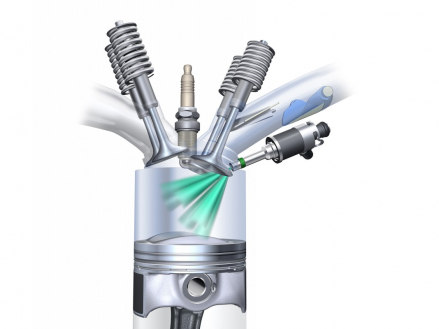FSI/TFSI principle
At Audi, FSI stands for gasoline direct injection, a technology in which fuel is injected directly into the combustion chambers, rather than into the intake manifold in the traditional manner. More favorable in terms of thermodynamics, this method improves the efficiency of the engine. FSI engines achieve higher performance and better dynamics than conventional engines, with better efficiency. Whether they have four, five, six, eight, ten or twelve cylinders, all gasoline engines from Audi today employ the FSI principle.
Another common trait of all Audi engines is the homogeneous fuel-air mixture. In a so-called stoichiometric ratio, one kilogram (2.207 lb) of gasoline mixes with 14.7 kilograms (32.41 lb) of air – equivalent to a volume of approximately 12,400 liters (437.90 cubic ft), since air is extremely light.
A turbocharger or supercharger makes a TFSI out of an FSI. In 2004 Audi was the first manufacturer worldwide to combine forced induction with gasoline direct injection. The two technologies harmonize perfectly: the directly injected fuel swirls intensely in the combustion chamber, which in turn cools the walls of the combustion chamber. This solves an old problem with turbo technology – the tendency toward early spontaneous ignition of the mixture at hot spots in the combustion chamber due to strong heat build-up at high compression, a phenomenon known as knocking. With its TFSI engines, Audi can achieve high compression ratios, to the benefit of combustion quality and thermodynamic efficiency – and consequently fuel efficiency.
Like TDI engines, FSI and TFSI engines from Audi obtain fuel through a common rail injection system. In the gasoline engines, however, significantly lower injection pressures of about 150 bar (2,176 psi) are sufficient, owing to the lower compression ratios of these engines versus self-igniting diesel engines. The primary advantages are the same as in the TDI: the compact design of the system and the freedom it allows for controlling the injection event.
Status: 2011
